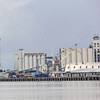By Bill West, contributing editor
The decision to repower a vessel is a multi-faceted one, and it can be safely assumed that no two decisions in this arena are exactly the same. Whether it's a crewboat that needs new power units to accommodate a new scope of operation; extending the life of an old, but otherwise stable boat; a rip and refit to replace under performing engines; or as a simple factor in the overall vessel conversion equation - the decision to install new engines on a vessel entails a significant financial investment for the owner. This year has seen a number of significant and unique marine repowerings. The vessels covered in this report are unique in that they range from a 149-passenger tour boat to an 846-ft. long military freighter powered by gas turbine engines.
Also unique is the extent of the work mandated for each vessel, as repower jobs often require a well-thought engineered solution for matters from determining the best mechanical solution to physically getting the old unit out and the new one in.
USNS Lance Corporal Roy M. Wheat
Certainly the largest, costly and most complex of these four projects is the USNS Lance Corporal Roy M. Wheat. This vessel has been at Bender Shipbuilding and Repair for the last four years and because of its size the ship has become almost a permanent landmark on the Mobile, Ala. skyline.
The 746-ft. by 98-ft. vessel was built 14 years ago in the Ukraine as a RoRo freighter.
Purchased in 1997 by the Military Sealift Command, the vessel is slated to become a part of MSC's Maritime Prepositioning Force carrying enough equipment and supplies to equip a marine division.
After arrival at Bender, the freighter had a 118-ft. midbody section added and since then the vessel has been significantly upgraded including replacement of its original Ukrainian gas turbines with upgraded engines by the same manufacturer, Zorya Production Associates.
These engines are heavy-duty marine grade gas turbine power plants that operate similarly to aircraft engines. The engines produce 18,000 hp each. Because gas turbine engines produce great amounts of waste heat, this heat is used to fire steam turbines that also connect into the reduction gear producing an additional 5,300 hp per shaft. The total hp of 23,300 per engine can propel the fully loaded freighter to 24-27 knots.
Several other power plants on the ship were either overhauled or replaced. Wärtsilä overhauled the bowthruster powered by a Wärtsilä engine at its Ft. Lauderdale facility. A Kamewa stern thruster was added driven by a 650 kW electric motor. The project also called for reworking three diesel engine gensets powered by existing Sulzer engines. New KATO Engineering generator front ends were added to these three gensets. To meet added demands for electrical power due to increased air conditioning and ventilation loads, a pair of Caterpillar 3516B gensets was added to the ship, each generating 1,825 kW of electric power. Rounding out the power needs of the Roy M. Wheat is a Caterpillar 3508B producing 850 kW of emergency power.
The vessel is one of a very few that utilizes the four main methods of ship power…steam, electric motor, diesel engine and gas turbine. The vessel is due to be completed by the end of the year at a cost of over $134 million. This project represents Bender's largest single ship contract.
It also represents a significant achievement for Bender. For example vessel documentation was in Russian that had to be translated. Bender's Engineering Department had to totally reengineer much of the vessel since it was changed significantly with the addition of the midbody section and other additions such as the topside forward and aft enclosed "houses" to store additional cargo.
Featured videos

Tracking Foreign Vessels Working in the U.S. Jones Act Market

Inside the Electrified Truckable Tug

Inmarsat Enhances Service to Drive Digitalization
Subscribe for
Maritime Reporter E-News
Maritime Reporter E-News is the maritime industry's largest circulation and most authoritative ENews Service, delivered to your Email five times per week








